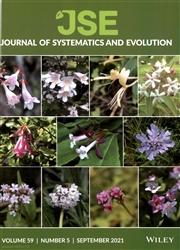全面的系统发生组分析揭示了葫芦形目内更高层次的系统发生关系
IF 2.9
1区 生物学
Q1 Agricultural and Biological Sciences
引用次数: 0
摘要
葫芦形目具有显著的形态、生态和行为多样性,是鞘翅目中进化最成功的类群。然而,鳞翅目超科之间的系统发育关系仍然难以捉摸。为了解决这些问题,我们对这一支系进行了基于转录组的宏观进化研究。我们对Curculionoidea超科的三个物种(两个来自Curculionidae,一个来自Brentidae)的基因组和转录组进行了测序,并从143个Cucujiformia物种中获得了超过569 990个氨基酸比对的数据集。有了迄今为止最完整的全基因组和转录组,我们比较了不同数据矩阵与通用单拷贝直向同源物(USCO)的性能。基于不同数据集的结果树在大多数深度节点上是一致的。两个 USCO 氨基酸矩阵(即 USCO75 和 USCO750-abs80)提供了很好的拓扑结构。分析结果证实,Cucujoidea sensu Robertson 等(2015 年)是一个非单系群,由 Erotyloidea、Nitiduloidea 和 Cucujoidea sensu Cai 等(2022 年)组成。此外,Erotyloidea 是早期分化的类群,其次是 Nitiduloidea 支系。首选的拓扑结构支持 Coccinelloidea 从其余超科中 "基本 "分裂,Cleroidea 形成第二个分裂群。Cucujiformia 在超科水平上支持以下系统发生:(Coccinelloidea)、(Cleroidea)、((Lymexyloidea)、(Tenebrionoidea)、(Erotyloidea)、(Nitiduloidea)、(Cucujoidea)、(Chrysomeloidea)、(Curculionoidea))))))))。我们的综合分析恢复了葫芦形目中层次较高的系统发育关系,为理解其进化历史提供了一个稳定的框架。本文章由计算机程序翻译,如有差异,请以英文原文为准。
Comprehensive phylogenomic analyses revealed higher‐level phylogenetic relationships within the Cucujiformia
The Cucujiformia, with remarkable morphological, ecological, and behavioral diversity, is the most evolutionarily successful group within Coleoptera. However, the phylogenetic relationships among superfamilies within Cucujiformia remain elusive. To address the issues, we conducted a transcriptome‐based macro‐evolutionary study of this lineage. We sequenced the genomes and transcriptomes of three species from the superfamily Curculionoidea (two from Curculionidae and one from Brentidae), and obtained a data set of more than 569 990 amino acid alignments from 143 species of Cucujiformia. With the most complete collection of whole genomes and transcriptomes so far, we compared the performance of different data matrices with universal‐single‐copy orthologs (USCO). The resultant trees based on different data sets were consistent for the majority of deep nodes. Two USCO amino acid matrices (i.e., USCO75 and USCO750‐abs80) provided well‐resolved topology. The analyses confirm that Cucujoidea sensu Robertson et al. 2015 is a nonmonophyletic group, consisting of Erotyloidea, Nitiduloidea, and Cucujoidea sensu Cai et al. 2022. Moreover, Erotyloidea is the early‐diverging group, followed by the clade Nitiduloidea. The preferred topologies supported a “basal” split of Coccinelloidea from the remaining superfamilies, and Cleroidea formed the second splitting group. The following phylogeny was supported at the superfamily level in Cucujiformia: (Coccinelloidea, (Cleroidea, ((Lymexyloidea, Tenebrionoidea), (Erotyloidea, (Nitiduloidea, (Cucujoidea, (Chrysomeloidea, Curculionoidea))))))). Our comprehensive analyses recovered well‐resolved higher‐level phylogenetic relationships within the Cucujiformia, providing a stable framework for comprehending its evolutionary history.
求助全文
通过发布文献求助,成功后即可免费获取论文全文。
去求助
来源期刊

Journal of Systematics and Evolution
Agricultural and Biological Sciences-Ecology, Evolution, Behavior and Systematics
CiteScore
7.40
自引率
8.10%
发文量
1368
审稿时长
6-12 weeks
期刊介绍:
Journal of Systematics and Evolution (JSE, since 2008; formerly Acta Phytotaxonomica Sinica) is a plant-based international journal newly dedicated to the description and understanding of the biological diversity. It covers: description of new taxa, monographic revision, phylogenetics, molecular evolution and genome evolution, evolutionary developmental biology, evolutionary ecology, population biology, conservation biology, biogeography, paleobiology, evolutionary theories, and related subjects.
 求助内容:
求助内容: 应助结果提醒方式:
应助结果提醒方式:


